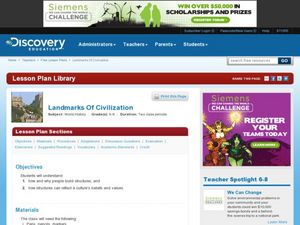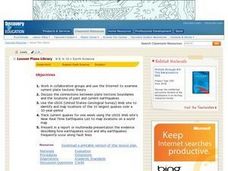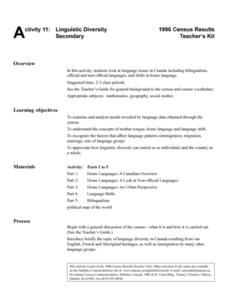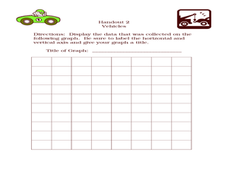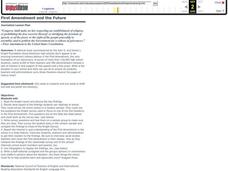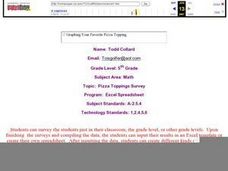Curated OER
Insects
Students observe and identify insects in their local. They record their observations by drawing a picture of the insect and writing a description.
Curated OER
A Day in the Life of Bill C-One
Students explore the procedures that make bills into laws, identify the sources of opinion that form debates, bills, and laws and engage in part of the process by discussing whether or not a bill should become a law.
Curated OER
Landmarks Of Civilization
Learners research famous landmarks of the world. In this landmarks lesson, students determine why cultures build special structures and then find out more about specific world landmarks. Learners respond to the provided discussion...
Curated OER
Green Food Graph
Students explore graph making by investigating St. Patrick's day food. In this holiday food lesson, students discuss their favorite green foods in honor of St. Patrick's day. Students create a graph based on the data of which green foods...
Curated OER
Health (General Wellness)
Seventh graders explore their personal health by completing a worksheet. In this healthy living lesson, 7th graders examine the health triangle and research ways to prevent at risk behavior. Students complete a health survey...
Curated OER
Earthquakes And Fault Lines
Students discuss major causes of earthquakes and identify famous fault lines, access and map information about ten largest earthquakes in world from 1989 to 1998, and theorize about location of these earthquakes as they relate to Earth's...
Curated OER
Alaska Purchase Debate
Students examine the benefits and the challenges Alaska has presented to the United States. They research what the government and the people of the United States considered at the time of the purchase of Alaska in order to debate the...
Curated OER
Food Label Scavenger Hunt Lesson: Worksheet with Twenty-one Food Lab
Students investigate the nutritional value of foods. In this scavenger hunt lesson, students compare various foods using food labels to determine their calories, fat, saturated fat, sodium, sugar, and protein. There is a link to the...
NOAA
Plankton
Dive into the world of plankton. The 17th installment of a 23-part NOAA Enrichment in Marine sciences and Oceanography (NEMO) program introduces different types of plankton. Young scientists then use what they have learned to classify...
National Security Agency
Partying with Proportions and Percents
Examine ratios and proportions in several real-world scenarios. Children will calculate unit rates, work with proportions and percentages as they plan a party, purchase produce, and take a tally. This lesson plan recommends five...
Curated OER
Linguistic Diversity Secondary
Don't be scared off by the title! Read this information packet with your class, or send them off on their own. After each section, you'll find a series of comprehension questions. Great preparation for state testing!
EngageNY
Putting the Law of Cosines and the Law of Sines to Use
Use the Law of Cosines and the Law of Sines to solve problems using the sums of vectors. Pupils work on several different types of real-world problems that can be modeled using triangles with three known measurements. In the process,...
EngageNY
Cones and Spheres
Explore methods for finding the volume of different three-dimensional figures. The 20th lesson plan in the 25-part series asks learners to interpret diagrams of 3-D figures and use formulas to determine volume. Scholars must use the...
Curated OER
Show Me The Data!
Pupils create a bar graph. They will collect and organize data to turn into bar graphs. They create graphs for the favorite sports of the class, color of M&M's, and types of cars passing by.
Curated OER
First Amendment and the Future
Students read the Knight report and discuss key findings before deciding what aspects of the findings students can replicate in their own school and conduct a survey. They write survey questions and test them on sample group before...
Curated OER
A Rewarding Endeavor
Develop and conduct a survey to find out if people would return an envelope of money they found. Include options for giving it to the police, advertising for the one who lost it, etc. The survey results are published in a writing piece.
Curated OER
A Picture is Worth a Thousand Words: Introduction to Graphing
Students practice graphing activities. In this graphing lesson, students discuss ways to collect data and complete survey activities. Students visit a table and graphs website and then a create a graph website to practice graphing.
Curated OER
Physical Activity Can Reduce Your Stress
Identify sources of stress in your students' everyday lives. They are introduced to ways in which they can relieve stress and consider the value of physical activity in overall health.
Curated OER
Graphing Your Favorite Pizza Topping
Fifth graders can survey the students just in their classroom, the grade level, or other grade levels. Upon finishing the surveys and compiling the data, the students can input their results in an Excel template or create their own...
Curated OER
Targeting Young Speeders
Young scholars research the police ticketing of teens in their city or county. They determine if the police are targeting teens and why. Students explore other ways the community tries to ensure safer teen drivers. They survey teens in...
Curated OER
Graphs: All About Our Class
Students respond to survey questions, discuss results, brainstorm ways to represent survey information, and create table of class results. They find mean, range, and percentages, and create graph to display results.
Curated OER
Measuring Civic Engagement
Students begin the lesson by defining what a citizen is in today's society. In groups, they brainstorm a list of qualities and responsibilites a good citizen should have. They also develop and give a survey that measures the amount of...
Curated OER
Journalism: Bullying Research
Students, after conducting extensive research about bullying, assemble their information into written and visual presentations. They write articles, conduct surveys, and develop infographics and other visuals.
Curated OER
What do Maps Show: How to Read a Topographic Map
Middle schoolers identify the characteristics of topographical maps. Using examples, they practice reading them and describing the information they gather from them. They also discover how to use the website from the U.S. Geological Survey.


